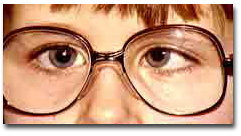| Essential topics/experience:
To have become familiar with the following: i. Concomitant strabismus: screening
strategies; epicanthus; accommodative aspects;
ii. Amblyopia: anisometropic, stimulus-deprivation, strabismic; prevention and treatment using occlusion. iii. Incomitant strabismus: cranial nerve palsies including diabetic mononeuropathies; significance of painful third nerve palsy and of pupil sparing; prediction of post-operative diplopia. iv. Liaison: with neurologists, orthoptists. Practical skills:
i. Eye movement evaluation. ii. Cover test (including alternate and prism). iii. Stereo tests. iv. Cycloplegic refraction. v. Horizontal muscle surgery. Background theory/principles:
i. Nystagmus. ii. Ocular motility syndromes (Duane’s, Brown’s). iii. Use of botulinum toxin. iv. Ocular myopathies and the neuromuscular junction. v. Supranuclear eye movement disorders. vi. Fresnel prisms. vii. Oblique muscle, vertical muscle and adjustable suture surgery. viii. Electromyography. |
|||
|
